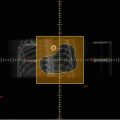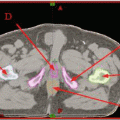(1)
University of Miami Sylvester Cancer Center, Miami, Florida, USA
Patient immobilization and positioning is very important in radiotherapy (RT). There are 2 aspects to immobilizing and positioning a patient that we must be concerned about: intra-treatment (during the actual delivery) motion and immobilization and inter-treatment (reproducibility from one fraction to the next) motion and immobilization. To ensure that the patient is positioned and immobilized properly for every fraction, immobilization devices and imaging techniques are used.
The purpose of intra-treatment immobilization is to ensure that the patient is not moving during dose delivery and remains in the same position as simulation. An exception to this is when gating is used because the delivery is controlled by patient respiration so motion is expected. In a standard treatment plan, a margin to account for patient motion is added to the clinical target volume (CTV) to ensure that the CTV is always covered in treatment. The added margin is called the planned target volume (PTV). The PTV margin is determined based on the uncertainty in the patient positioning, the amount of motion the target experiences, and the proximity of critical structures. Without an immobilization device, e.g., a mask for head/neck treatments, the PTV margin would have to be very large to ensure that the CTV does not move outside of the PTV and receives the appropriate dose. Another way of reducing the uncertainty in patient setup is to use image guidance like orthogonal x-rays or cone beam CT (CBCT).
The purpose of inter-treatment immobilization is to ensure the reproducibility of every fraction of treatment. The role of the PTV is also to ensure CTV coverage during every fraction, and using an immobilization device or image guidance can help reproduce the patient’s position daily so that the CTV is covered by the prescription dose.
It is important to mention the procedures of post-planning simulation (so-called second simulation). After a plan is calculated and approved on the simulation CT, a patient will often undergo a second simulation and have external marks placed such as tattoos or BBs, to localize the treatment isocenter prior to treatment, as well as be able to reproduce the patient’s position at every fraction. This can be done in a simulator using fluoroscopy to visualize the patient’s anatomy and treatment area, or nowadays, most linear accelerators have KV imaging capabilities allowing for the second simulation to be done on the linac. In the case of image-guided radiotherapy (IGRT), target localization is also confirmed visually with imaging prior to each fraction. The choice to use image guidance is based on the complexity of the treatment and the proximity of OARs. An IMRT plan with steep dose gradients requires more accurate positioning to ensure the dose is being delivered to the correct area.
4.1 Patient Positioning and Treatment Devices (Questions)
Quiz 1 (Level 2)
1.
Which of the following devices is/are used for patient positioning reproducibility?
A.
I, II, and III
B.
I and III only
C.
II and IV only
D.
IV only
E.
All are correct
I.
Total body cast
II.
Triangle pillow under knees
III.
Headrest
IV.
Arm support
2.
Daily patient-treatment setup positions include:
A.
I, II, and III
B.
I and III only
C.
II and IV only
D.
IV only
E.
All are correct
I.
Supine
II.
Prone
III.
Head and thorax slightly upright
IV.
Trendelenburg
3.
Which of the following treatments can benefit from using an Alpha Cradle mold for patient immobilization?
A.
RT of head and neck and nasopharynx
B.
RT of lower leg sarcoma
C.
RT of chest wall
D.
RT of whole brain
4.
Which of the following treatment devices is used to move the small bowel away from the treatment field?
A.
Alpha Cradle
B.
Aquaplast mask
C.
Belly board
D.
Bite block
5.
Patient’s positioning and the immobilization device used depend on:
A.
I, II, and III
B.
I and III only
C.
II and IV only
D.
IV only
E.
All are correct
I.
Patient’s medical condition
II.
CT scanner bore dimension
III.
Location of the disease
IV.
Patient’s preference
6.
Which of the following devices is/are used for immobilization of head and neck radiation treatments?
A.
I, II, and III
B.
I and III only
C.
II and IV only
D.
IV only
E.
All are correct
I.
Aquaplast mask
II.
Shoulder straps
III.
Headrest
IV.
Bite block
7.
Which of the following devices is/are used for immobilization of thorax radiation treatment?
A.
I, II, and III
B.
I and III only
C.
II and IV only
D.
IV only
E.
All are correct
I.
Vac-Lok bag
II.
Alpha Cradle
III.
Wing board
IV.
Prone pillow
8.
Which of the following devices is used for immobilization CNS patients?
A.
Sandbags
B.
Belly board
C.
Wing board
D.
Duncan face mask
9.
The belly board’s main advantage is:
A.
Minimize lung dose
B.
Reduce pelvic tilt
C.
Reproducibility
D.
Minimize small bowel dose
10.
What is the Calypso® 4D localization system used for?
A.
Intra-fractional prostate motion tracking
B.
Inter-fractional prostate motion tracking
C.
Intra-fractional prostate motion monitoring
D.
Inter-fractional prostate motion monitoring
11.
Which of the following are components of Calypso® 4D systems?
A.
I, II, III, and IV
B.
II, III, and IV
C.
I, III, and IV
D.
All of them
I.
4D electromagnetic array
II.
Implanted electromagnetic transponders
III.
4D console inside treatment room
IV.
4D tracking system
V.
Infrared cameras and optic targets
4.2 Image-Guided Radiotherapy (Questions)
Quiz 1 (Level 2)
1.
Image-guided radiotherapy (IGRT) refers to:
A.
A RT delivery technique where an image is acquired just before or during delivery of a fraction to improve the accuracy of target localization for delivery and avoidance of organs at risk
B.
View of patient through the beam portal image showing patient anatomy within treatment beam
C.
A combined radiation therapy technique in which a single beam is irradiated both with an electron and a photon beam
D.
An x-ray film taken on the treatment machine with the patient in treatment position and with the beam settings as used for treatment
2.
Some IGRT systems include:
A.
I, II, and III
B.
I and III only
C.
II and IV only
D.
IV only
E.
All are correct
I.
Cone beam computed tomography (CBCT)
II.
Megavoltage computed tomography (MVCT)
III.
Portal imaging
IV.
Online imaging with paired orthogonal planar images
3.
Which of the following IGRT systems enable visualization of the exact tumor location by integrating a CT imaging system with a linac and involve acquiring multiple planar images?
A.
BAT
B.
BrainLab
C.
Paired orthogonal planar imagers
D.
CBCT
4.
The advantage of megavoltage beams for CBCT is:
A.
The beams come from the linac beamline and thus no additional equipment is required to produce the cone beam.
B.
It produces better soft tissue contrast.
C.
It is lower energy.
D.
It can produce radiographic and fluoroscopic images.
5.
Get Clinical Tree app for offline access

A CT-on-rails system is comprised of:
A.
A detector panel already present for use in electronic portal imaging opposite to the linac head
B.
A conventional x-ray tube mounted on a retractable arm at 90° to the high-energy treatment beam and a flat panel x-ray detector mounted on a retractable arm opposite the x-ray tube
C.




A linac and a CT unit on rails approach at opposite ends of a standard radiotherapy treatment table
Stay updated, free articles. Join our Telegram channel

Full access? Get Clinical Tree






